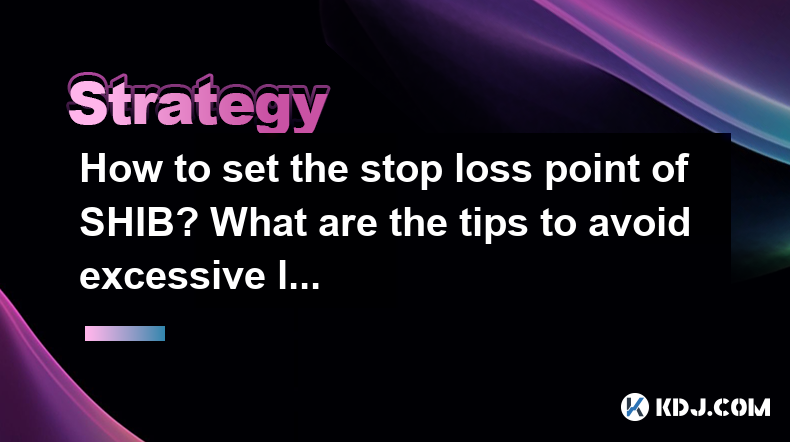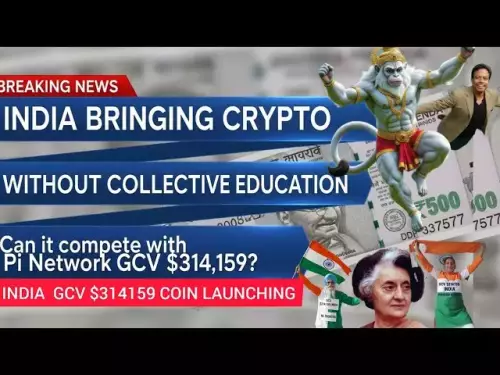-
 bitcoin
bitcoin $112715.707551 USD
-1.71% -
 ethereum
ethereum $4101.475385 USD
-3.01% -
 tether
tether $1.000644 USD
-0.02% -
 bnb
bnb $1207.619465 USD
-6.77% -
 xrp
xrp $2.501451 USD
-3.98% -
 solana
solana $202.947124 USD
-3.32% -
 usd-coin
usd-coin $1.000295 USD
0.04% -
 dogecoin
dogecoin $0.203884 USD
-4.47% -
 tron
tron $0.317154 USD
-1.72% -
 cardano
cardano $0.695009 USD
-4.43% -
 hyperliquid
hyperliquid $38.853961 USD
-8.23% -
 chainlink
chainlink $18.988674 USD
-4.64% -
 ethena-usde
ethena-usde $1.000233 USD
-0.03% -
 stellar
stellar $0.337050 USD
-3.63% -
 bitcoin-cash
bitcoin-cash $536.861728 USD
-1.28%
How to set the stop loss point of SHIB? What are the tips to avoid excessive losses?
Setting a stop loss for SHIB can protect your investment from sudden downturns by selling at a predetermined price, helping manage risk in volatile crypto markets.
Apr 29, 2025 at 05:00 am

Understanding Stop Loss in Cryptocurrency Trading
Setting a stop loss is a critical strategy for managing risk in cryptocurrency trading, especially when dealing with volatile assets like Shiba Inu (SHIB). A stop loss order is an instruction to sell a cryptocurrency when it reaches a certain price level, which helps to limit an investor's loss on a position. This is particularly important in the crypto market, where price fluctuations can be extreme and rapid.
Why Set a Stop Loss for SHIB?
SHIB, known for its high volatility, can experience significant price swings within short periods. Setting a stop loss for SHIB can protect your investment from sudden downturns. By predetermining the price at which you will sell your SHIB, you can prevent emotional decision-making during market dips and ensure that your losses do not exceed a certain threshold.
How to Set a Stop Loss Point for SHIB
To set a stop loss for SHIB, you will need to use a trading platform that supports stop loss orders. Here’s how you can do it on a typical exchange:
- Log into your trading account: Access the platform where you hold your SHIB.
- Navigate to the trading section: Find the section where you can trade SHIB.
- Select SHIB as the asset: Choose SHIB from the list of available cryptocurrencies.
- Choose the order type: Select ‘Stop Loss’ or ‘Stop Order’ from the order types.
- Set the stop price: Enter the price at which you want the stop loss to trigger. For example, if SHIB is currently trading at $0.000010 and you want to limit your loss to 10%, you would set the stop price at $0.000009.
- Set the sell price: Some platforms allow you to set a limit price for the sale. If the stop price is hit, the order will be placed as a limit order at the sell price you specify.
- Review and confirm: Double-check all the details and submit your stop loss order.
Tips to Avoid Excessive Losses with SHIB
While setting a stop loss is a good start, there are additional strategies you can employ to minimize losses when trading SHIB:
- Use Technical Analysis: Study SHIB’s price charts and use indicators like moving averages, RSI, and Bollinger Bands to identify potential support and resistance levels. This can help you set more informed stop loss points.
- Consider Volatility: SHIB is known for its high volatility. Set your stop loss with enough buffer to account for normal price fluctuations to avoid being stopped out prematurely.
- Diversify Your Portfolio: Do not put all your funds into SHIB. Diversifying across different cryptocurrencies can reduce the risk associated with any single asset.
- Stay Informed: Keep up with news and developments related to SHIB. Announcements or market trends can significantly impact SHIB’s price, and being informed can help you adjust your stop loss accordingly.
- Use Trailing Stops: A trailing stop adjusts the stop price at a fixed percentage or dollar amount below the market price as it rises. This can help lock in profits while still providing downside protection.
Common Mistakes to Avoid When Setting Stop Loss for SHIB
- Setting the Stop Loss Too Tight: If your stop loss is too close to the current price, you might be stopped out due to normal market volatility. Ensure your stop loss gives the asset enough room to breathe.
- Ignoring Market Conditions: Failing to adjust your stop loss based on current market conditions can lead to unnecessary losses. Always reassess your stop loss in light of new market data.
- Overlooking Transaction Fees: Remember that selling SHIB at your stop loss point will incur transaction fees. These fees can eat into your remaining funds, so factor them into your stop loss calculations.
Practical Example of Setting a Stop Loss for SHIB
Imagine you bought SHIB at $0.000010 and want to limit your loss to 15%. Here’s how you would set your stop loss:
- Current Price: $0.000010
- Desired Loss Limit: 15%
- Stop Loss Price: $0.000010 - ($0.000010 * 0.15) = $0.0.0000085
You would set your stop loss at $0.0000085. If SHIB’s price falls to this level, your stop loss order will be triggered, and your SHIB will be sold, limiting your loss to 15% of your initial investment.
Frequently Asked Questions
Q1: Can I set a stop loss on all cryptocurrency exchanges?A1: Not all exchanges support stop loss orders. It’s important to check if your chosen platform offers this feature before trading. Exchanges like Binance, Coinbase Pro, and Kraken do support stop loss orders.
Q2: What should I do if my stop loss is triggered?A2: If your stop loss is triggered, evaluate the market conditions before making your next move. You might decide to re-enter the market at a lower price or move your funds to a different asset. Always have a plan in place for post-stop loss actions.
Q3: How often should I adjust my stop loss for SHIB?A3: There’s no one-size-fits-all answer, but it’s wise to review your stop loss regularly. Factors like SHIB’s price movement, market news, and your overall investment strategy should guide your adjustments. Some traders adjust their stop loss daily, while others do so weekly or based on specific market events.
Q4: Is it better to use a stop loss or a take profit order for SHIB?A4: Both stop loss and take profit orders are important. A stop loss protects against significant losses, while a take profit order helps lock in gains. For SHIB, using both can provide a balanced approach to managing your trades, ensuring you can limit losses and secure profits.
Disclaimer:info@kdj.com
The information provided is not trading advice. kdj.com does not assume any responsibility for any investments made based on the information provided in this article. Cryptocurrencies are highly volatile and it is highly recommended that you invest with caution after thorough research!
If you believe that the content used on this website infringes your copyright, please contact us immediately (info@kdj.com) and we will delete it promptly.
- Coinbase vs. Binance: Navigating the BNB Listing Landscape
- 2025-10-16 06:40:01
- Canadian Coin Alert: Is That Gold Penny Worth a Fortune?
- 2025-10-16 06:40:01
- PayPal, PYUSD, and Stablecoins: Riding the Wave of Digital Finance
- 2025-10-16 04:50:01
- Milk Mocha's $HUGS Token: Why the Whitelist & Presale 2025 are Exploding
- 2025-10-16 04:30:01
- DeepSnitch AI: The Next Big Thing on BNB Chain and Binance Listings?
- 2025-10-16 05:43:02
- Microsoft, Bitcoin, and GitHub: A Balancing Act in the Digital Age
- 2025-10-16 04:30:01
Related knowledge

Practical parameter settings for a Bitcoin multi-timeframe moving average system
Sep 18,2025 at 10:54pm
Optimizing Timeframe Combinations for Bitcoin Trading1. Selecting appropriate timeframes is crucial when building a multi-timeframe moving average sys...

How can I filter out false breakouts in Dogecoin high-frequency trading?
Sep 22,2025 at 01:00am
Understanding False Breakouts in Dogecoin Trading1. A false breakout occurs when Dogecoin's price appears to move beyond a defined support or resistan...

Techniques for identifying tops and bottoms in the Bitcoin on-chain NVT model
Sep 20,2025 at 07:54pm
Understanding the NVT Model in Bitcoin Analysis1. The Network Value to Transactions (NVT) ratio is often described as the 'P/E ratio' of the cryptocur...

What does the surge in open interest in Bitcoincoin futures mean?
Sep 20,2025 at 11:18pm
Understanding the Surge in Dogecoin Futures Open Interest1. A surge in open interest within Dogecoin futures indicates a growing number of active cont...

How can I use the Ethereum USDT premium to gauge market sentiment?
Sep 18,2025 at 11:55pm
Understanding the Ethereum USDT Premium1. The Ethereum USDT premium refers to the price difference between USDT (Tether) traded on Ethereum-based plat...

What should I do if Ethereum staking yields decline?
Sep 20,2025 at 06:18am
Understanding the Causes Behind Declining Ethereum Staking Yields1. The Ethereum network transitioned to a proof-of-stake consensus mechanism with the...

Practical parameter settings for a Bitcoin multi-timeframe moving average system
Sep 18,2025 at 10:54pm
Optimizing Timeframe Combinations for Bitcoin Trading1. Selecting appropriate timeframes is crucial when building a multi-timeframe moving average sys...

How can I filter out false breakouts in Dogecoin high-frequency trading?
Sep 22,2025 at 01:00am
Understanding False Breakouts in Dogecoin Trading1. A false breakout occurs when Dogecoin's price appears to move beyond a defined support or resistan...

Techniques for identifying tops and bottoms in the Bitcoin on-chain NVT model
Sep 20,2025 at 07:54pm
Understanding the NVT Model in Bitcoin Analysis1. The Network Value to Transactions (NVT) ratio is often described as the 'P/E ratio' of the cryptocur...

What does the surge in open interest in Bitcoincoin futures mean?
Sep 20,2025 at 11:18pm
Understanding the Surge in Dogecoin Futures Open Interest1. A surge in open interest within Dogecoin futures indicates a growing number of active cont...

How can I use the Ethereum USDT premium to gauge market sentiment?
Sep 18,2025 at 11:55pm
Understanding the Ethereum USDT Premium1. The Ethereum USDT premium refers to the price difference between USDT (Tether) traded on Ethereum-based plat...

What should I do if Ethereum staking yields decline?
Sep 20,2025 at 06:18am
Understanding the Causes Behind Declining Ethereum Staking Yields1. The Ethereum network transitioned to a proof-of-stake consensus mechanism with the...
See all articles










































































